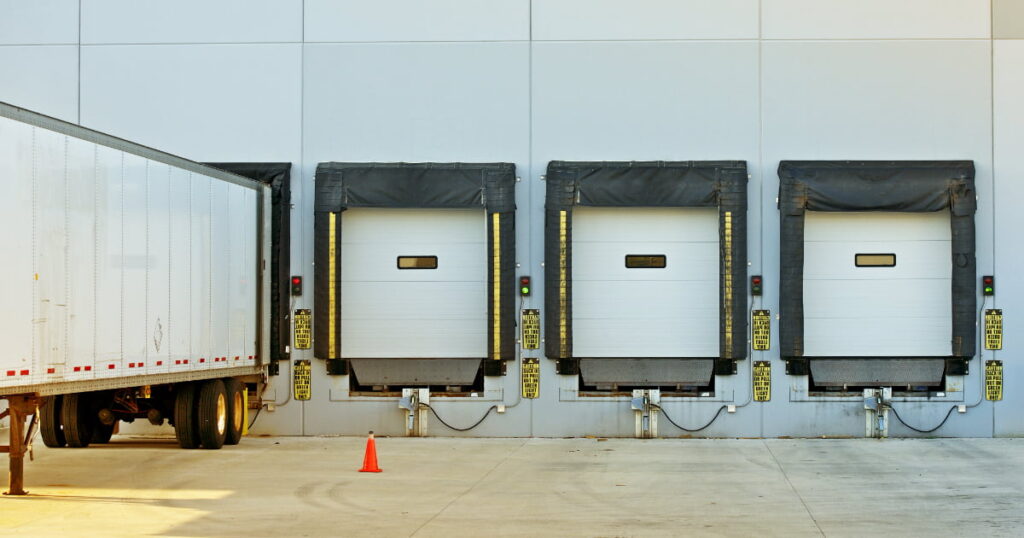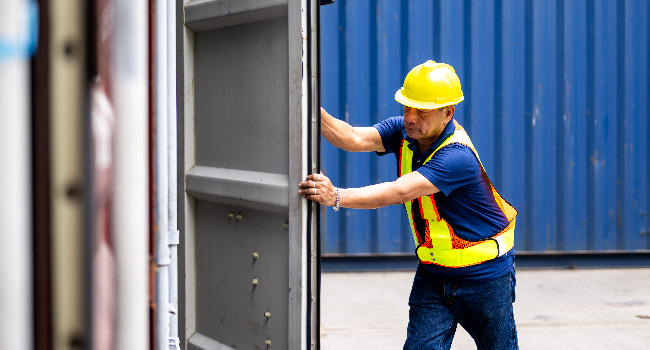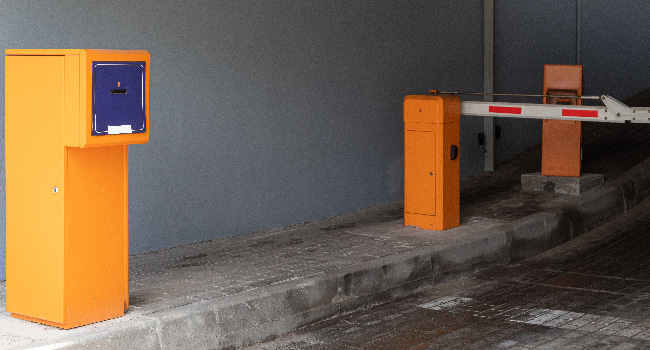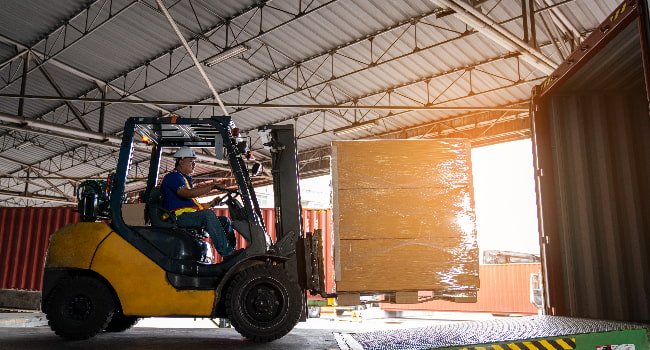A1 Quality Logistical Solutions

- By Haley
- May 13, 2025
Table of Contents
Key Highlights
- Loading dock doors play an integral role in ensuring efficient logistics operations, enabling faster order fulfillment and smoother supply chain processes.
- Multiple types of dock doors are employed in warehouses according to the warehouse location, operational needs, and the safety of warehouse workers.
- Advanced technologies improve dock door performance by increasing speed and efficiency in lumper service operations.
- Safety measures and protocols surrounding dock doors are crucial for greater customer satisfaction and reduced hazards.
- Regular maintenance of dock doors ensures product longevity and supports inventory management goals effectively.
Introduction
In the world of logistics operations, businesses need smooth supply chain systems to fulfill orders and ship items effectively. Loading dock doors play a key role in this. They help with high-volume logistics movements smoothly and accurately. These doors are important for lumper services. They help improve efficiency by connecting warehouse management and distribution systems. Whether you own a fulfillment center or play a role in ecommerce, dock doors can improve your speed and enhance customer satisfaction.
Understanding Loading Dock Doors in Lumper Services
Loading dock doors are designed to make order fulfillment faster, which means goods can move between transportation services and the warehouse more quickly. When dock doors work well, they help reduce shipping costs and keep warehouse workers safe. This leads to a better experience for customers. Knowing how they work helps with better coordination in fulfillment centers. It ensures that inventory management systems run smoothly, supporting the entire supply chain and allowing for quicker and more reliable customer orders.

The Role of Loading Dock Doors in Logistics
Loading dock doors are the link between logistics providers and distribution networks. These doors make sure that goods move safely and efficiently in and out of warehouses. This improves transportation management and freight forwarding. Dock doors speed up turnaround times and limit workflow problems by allowing smooth operations at many warehouse locations.
If you handle distribution services, run warehouse operations, or own logistics systems, dock doors make product handling easier and cut down on delays. They can adapt to different business needs, whether for large items like pallets or quick-paced eCommerce activities.
By speeding up loading and unloading, these doors help warehouse workers keep product lines and inventory levels steady. Dock doors act as key points, turning logistics processes into fast, reliable systems. Their strong features make them essential for supply chain providers who work under tight schedules.
Types of Loading Dock Doors Used in Warehouses
Different warehouse operations need dock doors that fit their logistics demands and building designs. Roll-up doors are a popular option because they are easy to use and save space. They work well in busy warehouse locations with lots of worker activity. Panel doors are good for insulation and security, keeping products safe even in extreme weather.
Warehouses that focus on customer orders or subscription services often use sectional doors. These doors allow quick operation and give better visibility. They help in speeding up the handling of goods, which is important for time-sensitive logistics services. Additionally, vertical lift doors are useful in spaces that need high clearance for elevators or large shipments.
Choosing the right dock doors depends on both available space and transportation management needs. Logistics efficiency gets better when warehouse workers can match door systems with other equipment. This makes these doors a key part of modern supply chain operations.
Safety Measures for Loading Dock Doors
Safety protocols involving dock doors help keep employees and goods safe while also making things run smoothly. To improve warehouse operations, strong safety features should work well alongside safety rules in logistics services. Regular check-ups and sticking to safety measures can stop accidents and help delivery systems work properly.
When we talk about safety, we need to think about hazards too. Good strategies protect freight handlers and warehouse workers from known risks. This helps keep things dependable, especially in busy logistics areas. Let’s look at key parts of these safety protocols.

Essential Safety Features for Dock Doors
Safety features for loading dock doors are pivotal. These include features such as pressure sensors and interlocks stop accidents when moving freight. Advanced technologies, such as automated safety systems linked with a warehouse management system, make logistics services even more reliable.
Loading dock doors that have fall protection barriers and warning lights lower risks during busy loading times. Using these features helps warehouses manage transportation more safely. It also improves efficiency and sustainability in fulfillment operations.
Innovations now include weatherproof seals. These protect products from damage while in warehouse storage. Adding these seals decreases inventory loss and increases customer satisfaction across distribution channels. By focusing on safety features like these, logistics providers enhance workplace standards.
Implementing Safety Protocols Around Dock Doors
Having strong safety rules for loading dock doors is required in logistics services. This is especially true in fulfillment centers. Clear procedures help warehouse workers align inventory with transport systems. This helps avoid injuries and waste during work. Managers often use transportation management tools linked with warehouse systems to make these rules easy to follow.
Safety also means checking that dock doors meet industry standards through regular audits and inspections. Warehouses that handle many products may use set practices such as updating sensors and systems to improve the entire process.
Training programs for logistics teams help workers spot and deal with risks early. This boosts their confidence when using complex loading doors. Following these safety protocols not only makes things safer but also stops common risks faced in freight-forwarding, especially as service providers grow.
Common Hazards and How to Avoid Them
Warehouse workers and freight handlers encounter many dangers when working at loading docks. These include vehicle collisions, falling items, and using equipment incorrectly. To reduce these risks, it is important to have safety protocols. This means securing loads and having clear communication among the team is crucial for logistics services. Freight forwarders often suggest using lane markings and physical barriers. These help define safe areas between moving equipment and workers.
There are common issues, such as malfunctioning doors and a lack of timely maintenance. These problems can disrupt workflows and cause missed deliveries. To avoid hazards, it is necessary to regularly check system integrity and provide practical training for all staff who access the dock.
Freight-forwarding companies have found that taking preventive steps and using risk-control strategies can save a lot of money by reducing inventory loss and worker injuries. They recommend adding these measures to reverse logistics systems for maximum efficiency. Safe practices help logistics providers keep operations running smoothly in busy warehouse environments.
Speed Optimization Through Advanced Dock Door Technology
Filling customer orders quickly needs advanced dock door technology that keeps up with changes in the supply chain. When lumper operations are faster, it lowers shipping costs and improves customer service. By maximizing their equipment, ecommerce businesses and fulfillment centers can meet the rising demands of consumers.
Let’s explore the technologies, see how they measure up, and look at case studies that show real success.

Technologies Enhancing the Efficiency of Dock Operations
Advanced dock door systems use the latest warehouse management software to improve the efficiency of logistics operations. These systems have real-time tracking and automatic controls. This helps to remove slowdowns caused by manual work, making loading and unloading go smoothly.
Technologies like motion-activated doors and AI sensors can tell different product types. They also change door functions to match transportation schedules. Fulfillment centers often use RFID-enabled systems. These systems make the whole supply chain better by cutting delays and spotting problems with inventory.
By speeding up tasks, upgrades to dock doors help deliver goods faster and improve safety for warehouse workers. Logistics services that use these technologies see more productivity and greater customer satisfaction. This advantage gives them a boost now and helps them stay competitive in a market that demands quick service.
Impact of High-Speed Doors on Lumper Service Turnaround Times
High-speed loading dock doors are game changers for fulfillment centers and logistics operations that focus on customer service. Their speed helps avoid delays when moving inventory. This greatly improves turnaround times for service providers who depend on precise coordination of customer orders.
These dock doors help lower shipping costs by reducing labor hours and making transportation systems more fuel-efficient. Fulfillment centers often see better operations directly tied to the efficiency of these door systems, which keep the queues moving quickly.
In ecommerce, saving time directly supports shipping strategies that aim for customer satisfaction. Meeting deadlines without delays lets fulfillment partners improve their performance in growing sales channels. This shows just how important tech-supported docks are in logistics processes.
Case Studies: Success Stories of Fast-Acting Dock Doors
Company | Industry | Results Achieved |
Amazon Warehouse | Ecommerce Retailers | Better logistics handling for more orders; quicker fulfillment processes |
Fast Freight Supplies | Logistics Providers | Lower shipping costs and faster service times using motion-sensor docks |
Ship-It Pro | Fulfillment Partners | Higher customer satisfaction by improving inventory with supply chains |
These cases show how businesses are using new dock door ideas to fix logistics problems. Ecommerce retailers, for example, speed up their shipping and supply chains by using smarter, faster systems. Fulfillment centers match rising demands with dependable service through better product development in dock technologies.
Maintenance Tips for Loading Dock Doors
Proper maintenance helps loading dock doors work at their best and last longer. A regular maintenance schedule keeps them functioning well over time. This also helps avoid delays in operations and supports your inventory management goals. Troubleshooting takes things further by spotting common problems early on.
Upgrading or replacing dock doors matches new warehousing needs with the latest innovations. This helps logistics providers stay ahead of supply chain challenges. Let’s look into effective solutions that are in progress.

Routine Maintenance Checklist for Longevity
Taking care of dock doors regularly helps performance and cuts down on delays in warehouse operations. Important tasks include:
1. Lubricating door frames often to stop rust.
2. Checking sensors to keep inventory aligned.
3. Cleaning to help products last longer.
Managers create maintenance schedules to meet the needs of customer service systems that are key for tracking inventory. These routines help keep everything running smoothly throughout each stage of the fulfillment process.
Checking regularly makes sure that everything works well and stays safe for logistics providers. Companies that depend heavily on order fulfillment systems enjoy better inspection methods, which make the doors more productive for longer.
Troubleshooting Common Issues with Dock Doors
Loading dock doors often face common problems. These include broken wires, mechanical issues, and unexpected stops. Fixing these problems in logistics services means finding wiring problems early and updating the software used in warehouse management tools.
Service providers work with technicians who deal with tricky troubleshooting tasks that affect the whole supply chain. To help prepare, they also use backup plans during busy times. This helps reduce gaps in service and keeps distribution running smoothly.
These flexible strategies help avoid bigger shutdowns. They also support better freight management in warehouse storage. Putting these actions into long-term service plans boosts the reliability of logistics services.
When to Consider a Dock Door Upgrade or Replacement
Warehouse managers need to think about the pros and cons before deciding to replace expensive equipment. Old systems that need hands-on attention show how time is moving from outdated setups to new ones. Easier methods help check the current inventory systems as needs change and product volume grows. Quick responses can reduce problems in the structure and help support better products and shipping. Success depends on effectively managing the whole system to meet goals.
Integration of Dock Doors with Loading Equipment
Bringing dock doors and loading equipment together is very important for improved operations. When dock doors, conveyors, and lifts align properly, order fulfillment gets more efficient and shipping costs drop. This smooth setup helps warehouse workers work with maximum efficiency, processing customer orders quickly. Also, advanced warehouse management software can help keep track of inventory and make operations smoother. Such integration not only boosts safety but also leads to greater customer satisfaction. It supports the logistics services provided by fulfillment partners.

Aligning Dock Doors with Conveyors and Lifts
When dock doors are aligned well with conveyors and lifts, it benefits logistics operations. This match allows products to move smoothly, which lowers wait times and cuts down on mistakes in handling. When dock doors are positioned correctly, warehouse workers can take care of inventory more easily. As a result, this teamwork not only boosts order fulfillment and reduces shipping costs but also increases customer satisfaction. By focusing on being efficient and safe, businesses can improve their transportation management strategies and make the most out of their warehouse space.
Safety and Efficiency in Equipment-Dock Door Coordination
Coordination between equipment and dock doors is required for safety and efficiency. When conveyors and lifts are lined up correctly, there are fewer chances of accidents while loading and unloading. This helps warehouse workers do their jobs safely. Good communication in logistics operations helps speed up order fulfillment. Using updated safety protocols can help meet OSHA rules and leads to greater customer satisfaction. It also makes shipping services more reliable and efficient. This teamwork helps achieve maximum efficiency throughout the entire supply chain.
Best Practices for Seamless Operation
To keep loading dock doors lined up well with conveyors and lifts, good communication and standard steps are helpful for warehouse workers. Using warehouse management software helps manage inventory better and allows for real-time tracking of shipping logistics. Also, regular checks on equipment are key to reduce downtime and ensure smooth order fulfillment. Training employees on how dock door operations work helps safety and boosts customer satisfaction. Following these best practices creates an environment that promotes maximum efficiency.
Regulatory Compliance and Industry Standards
Following OSHA rules about dock door safety helps protect warehouse workers and improves overall operations. By staying aware of industry standards, you can reduce risks in shipping logistics and inventory management. In today’s world, customer satisfaction is closely tied to good order fulfillment. Understanding compliance affects insurance and liability, which helps protect your business from problems in the supply chain. It is crucial for any logistics provider to focus on these key areas.

OSHA Regulations on Dock Door Safety
OSHA has strict safety standards for dock door operations. These rules say that dock doors must have safe features. This includes strong locks and better visibility. These features help prevent accidents, especially when working with a lot of inventory. Following these safety measures keeps warehouse workers safe and helps logistics operations run smoothly. Regular checks on dock doors help with shipping logistics and make sure safety rules are followed.
Staying Ahead with Industry Compliance
By taking steps to ensure safety at loading dock doors, businesses not only follow OSHA regulations but also lower risks in logistics operations. Compliance can make customer experience better and help build trust within the customer base. Also, using warehouse management systems can make the fulfillment process smoother, making sure that operations follow the rules. When businesses stay on top of compliance, they can secure long-term success, cut insurance costs, and keep a strong position in the changing logistics landscape.
How Compliance Impacts Insurance and Liability
Not following safety rules can cost businesses a lot of money. Loading dock doors that meet OSHA safety standards improve safety and lower accident risks. Insurance companies usually look at how well companies follow these rules when deciding on coverage and prices. Businesses that focus on following these regulations can save on shipping costs because they have fewer claims and better reputations in the logistics field. In the end, sticking to these standards protects valuable assets and ensures a smooth fulfillment process. This boosts customer satisfaction and trust among all service providers in the supply chain.
Cost Analysis of Upgrading Dock Doors
Upgrading dock doors is a smart choice for businesses in logistics. By improving these entry points, companies can make shipping logistics smooth and enhance order fulfillment. At first, the costs for upgrades might seem high. However, the savings over time usually make up for this, especially when it comes to lower shipping costs and better customer satisfaction. New dock doors can also make better use of warehouse space and handle more order volumes. Overall, these changes support a smoother operation and help a company stay ahead in the growing supply chain market.
Long-Term Savings vs. Upfront Costs
Investing in modern dock doors can be expensive at first. However, the savings in the long run can be very helpful. Better safety features lower injury costs and improve logistics operations. They help align with conveyors and lifts, which cuts down delays and increases productivity. This boosts order fulfillment and helps lower shipping costs. Also, less maintenance and better energy use mean lower operational costs over time. For warehouse operators, this leads to greater customer satisfaction. Timely deliveries improve their reputation and help keep customers in a tough market.
ROI Expectations from Modern Dock Doors
Investing in modern dock doors provides clear benefits that go beyond their initial costs. They come with better safety features. They also work well with conveyors and lifts, improving logistics operations. This leads to lower shipping costs and less downtime. These updates help increase the amount of orders fulfilled quickly. Faster shipping logistics meet customer orders more efficiently. When technology improves efficiency, customer satisfaction rises. Fulfillment partners can manage more order volumes smoothly. Over time, this brings a strong return on investment (ROI) that makes upgrading warehouse operations worthwhile.
Conclusion
The use of loading dock doors in lumper services is very important for improving logistics operations. Good dock doors help order fulfillment, which leads to greater customer satisfaction by allowing faster delivery times. They also help lower shipping costs by improving inventory management. As companies connect dock systems with transportation services, following safety rules is very nonnegotiable. This affects insurance and liability issues. In the end, updating dock doors can bring long-term benefits and help businesses stay ahead in the supply chain management world.
Frequently Asked Questions
What are the standard sizes for loading dock doors?
The usual sizes for loading dock doors are between 8×9 feet and 10×10 feet. You can also get custom sizes to meet your specific needs. This helps make loading and unloading easier. Think about what your operations need when choosing the best size for your loading dock.
How do high-speed dock doors enhance lumper service operations?
High-speed dock doors make lumper service operations better. They speed up loading and unloading. This means less time waiting and a safer environment. Their smart design helps save energy and keeps out bad weather. In the end, this helps things run smoothly and improves productivity in warehouses.
What are the top safety features to look for in a dock door?
When you choose a dock door, focus on important features like impact resistance, safety sensors, better visibility, and emergency stop buttons. These aspects help keep workers and equipment safe. They also make sure you follow safety rules, which helps lower risks in lumper service activities.
How often should loading dock doors be serviced?
Loading dock doors need to be checked at least once a year. This helps keep them working well and safe. In busy places, they might need inspections and maintenance more often. This depends on how much they are used, the weather, and how operations run. Regular servicing can stop expensive repairs and improve efficiency.

Haley serves as the Marketing Manager for A1 Quality Logistical Solutions. She joined A1QLS in 2023 with her prior experience gained with GXO and XPO Logistics.
